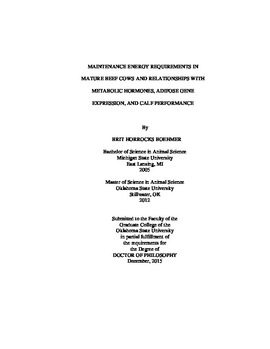| dc.description.abstract | Nonlactating, spring-calving Angus cows in mid to late gestation were used to determine variation in maintenance energy requirements (MR) and evaluate relationships between MR and concentrations of triiodothyronine (T3), thyroxine (T4), and IGF-I in plasma, genes associated with lipid homeostasis, and calf performance. Cows (4 to 7 yr of age) were evaluated in 3 yr (yr 1: n = 31; yr 2: n = 30; yr 3: n = 34) during mid to late gestation. Cows were individually fed a complete diet to meet predicted MR (NEm; Level 1 Model; NRC, 2000). Body weight of cows was recorded twice weekly and feed intake was adjusted every 14 d until constant BW (regression analyses) was achieved for at least 28 d (maintenance). Cows in each year were classified based on MR as low (LMR; > 0.5 SD less than mean MR), moderate (MMR; +- 0.5 SD of mean MR), or high (HMR; > 0.5 SD greater than mean MR). Blood samples were collected at maintenance in each year and during early lactation in yr 1 and yr 3. During maintenance, cows (yr 2: n = 14; yr 3: n = 20) were infused with thyrotropin releasing hormone (TRH) and blood samples were collected frequently from 60 min before to 360 min after TRH infusion. Plasma concentrations of T3, T4, and IGF-I were quantified by RIA. Longissimus dorsi muscle (LM) of LMR and HMR cows (n = 11) was biopsied at maintenance in yr 3. Relative mRNA abundance for sterol regulatory element binding factor 1 (SREBF1), fatty acid synthase (FASN), diacylglycerol acyltransferase 2 (DGAT2), and carnitine palmitoyltransferase 1B (CPT1B) was evaluated. Maintenance energy requirement (Kcal BW0.751) of cows was 81.0 +- 1.8, 83.1 +- 1.6, and 88.1 +- 1.3 in yr 1, 2, and 3, respectively. Body weight, BCS, and daily plasma concentrations of T3, T4, and IGF-I in cows were not influenced by MR. After infusion of TRH in yr 2, mean plasma concentrations of T4 were greater in MMR compared with LMR cows, which were greater than in HMR cows and T3:T4 was greater in HMR cows compared with LMR and MMR cows. In yr 3, LMR cows had greater plasma concentrations of T3 compared with HMR cows after TRH infusion. Low MR cows had greater expression of FASN mRNA compared with HMR cows. Performance of calves before weaning was not influenced by MR of cows. Thyroid hormones, IGF-I, and lipogenic genes may be components of potential biomarkers for MR of cows. Identification of biomarkers for MR may allow for selection of cows with reduced MR. | |
